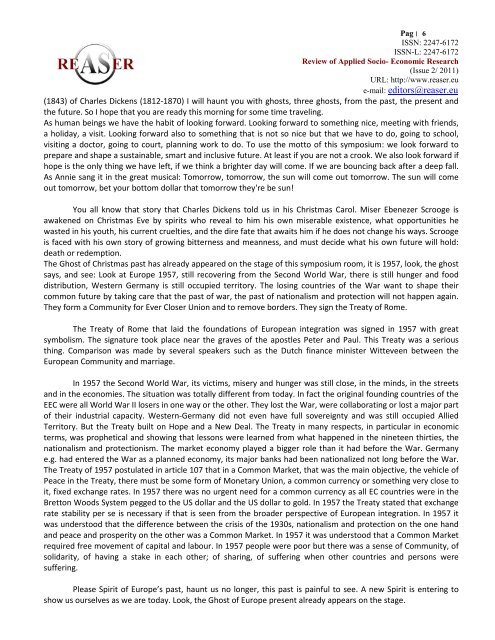Volume 2, ISSUE2/2011 - Review of Applied Socio-Economic ...
Volume 2, ISSUE2/2011 - Review of Applied Socio-Economic ...
Volume 2, ISSUE2/2011 - Review of Applied Socio-Economic ...
You also want an ePaper? Increase the reach of your titles
YUMPU automatically turns print PDFs into web optimized ePapers that Google loves.
Pag׀ 6 ISSN: 2247-6172ISSN-L: 2247-6172<strong>Review</strong> <strong>of</strong> <strong>Applied</strong> <strong>Socio</strong>- <strong>Economic</strong> Research(Issue 2/ <strong>2011</strong>)URL: http://www.reaser.eue-mail: editors@reaser.eu(1843) <strong>of</strong> Charles Dickens (1812-1870) I will haunt you with ghosts, three ghosts, from the past, the present andthe future. So I hope that you are ready this morning for some time traveling.As human beings we have the habit <strong>of</strong> looking forward. Looking forward to something nice, meeting with friends,a holiday, a visit. Looking forward also to something that is not so nice but that we have to do, going to school,visiting a doctor, going to court, planning work to do. To use the motto <strong>of</strong> this symposium: we look forward toprepare and shape a sustainable, smart and inclusive future. At least if you are not a crook. We also look forward ifhope is the only thing we have left, if we think a brighter day will come. If we are bouncing back after a deep fall.As Annie sang it in the great musical: Tomorrow, tomorrow, the sun will come out tomorrow. The sun will comeout tomorrow, bet your bottom dollar that tomorrow they're be sun!You all know that story that Charles Dickens told us in his Christmas Carol. Miser Ebenezer Scrooge isawakened on Christmas Eve by spirits who reveal to him his own miserable existence, what opportunities hewasted in his youth, his current cruelties, and the dire fate that awaits him if he does not change his ways. Scroogeis faced with his own story <strong>of</strong> growing bitterness and meanness, and must decide what his own future will hold:death or redemption.The Ghost <strong>of</strong> Christmas past has already appeared on the stage <strong>of</strong> this symposium room, it is 1957, look, the ghostsays, and see: Look at Europe 1957, still recovering from the Second World War, there is still hunger and fooddistribution, Western Germany is still occupied territory. The losing countries <strong>of</strong> the War want to shape theircommon future by taking care that the past <strong>of</strong> war, the past <strong>of</strong> nationalism and protection will not happen again.They form a Community for Ever Closer Union and to remove borders. They sign the Treaty <strong>of</strong> Rome.The Treaty <strong>of</strong> Rome that laid the foundations <strong>of</strong> European integration was signed in 1957 with greatsymbolism. The signature took place near the graves <strong>of</strong> the apostles Peter and Paul. This Treaty was a seriousthing. Comparison was made by several speakers such as the Dutch finance minister Witteveen between theEuropean Community and marriage.In 1957 the Second World War, its victims, misery and hunger was still close, in the minds, in the streetsand in the economies. The situation was totally different from today. In fact the original founding countries <strong>of</strong> theEEC were all World War II losers in one way or the other. They lost the War, were collaborating or lost a major part<strong>of</strong> their industrial capacity. Western-Germany did not even have full sovereignty and was still occupied AlliedTerritory. But the Treaty built on Hope and a New Deal. The Treaty in many respects, in particular in economicterms, was prophetical and showing that lessons were learned from what happened in the nineteen thirties, thenationalism and protectionism. The market economy played a bigger role than it had before the War. Germanye.g. had entered the War as a planned economy, its major banks had been nationalized not long before the War.The Treaty <strong>of</strong> 1957 postulated in article 107 that in a Common Market, that was the main objective, the vehicle <strong>of</strong>Peace in the Treaty, there must be some form <strong>of</strong> Monetary Union, a common currency or something very close toit, fixed exchange rates. In 1957 there was no urgent need for a common currency as all EC countries were in theBretton Woods System pegged to the US dollar and the US dollar to gold. In 1957 the Treaty stated that exchangerate stability per se is necessary if that is seen from the broader perspective <strong>of</strong> European integration. In 1957 itwas understood that the difference between the crisis <strong>of</strong> the 1930s, nationalism and protection on the one handand peace and prosperity on the other was a Common Market. In 1957 it was understood that a Common Marketrequired free movement <strong>of</strong> capital and labour. In 1957 people were poor but there was a sense <strong>of</strong> Community, <strong>of</strong>solidarity, <strong>of</strong> having a stake in each other; <strong>of</strong> sharing, <strong>of</strong> suffering when other countries and persons weresuffering.Please Spirit <strong>of</strong> Europe’s past, haunt us no longer, this past is painful to see. A new Spirit is entering toshow us ourselves as we are today. Look, the Ghost <strong>of</strong> Europe present already appears on the stage.








